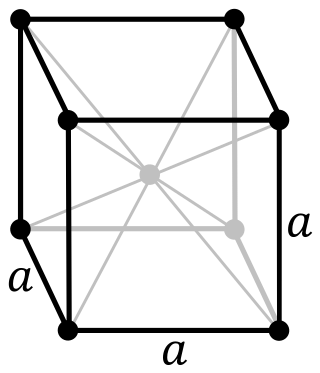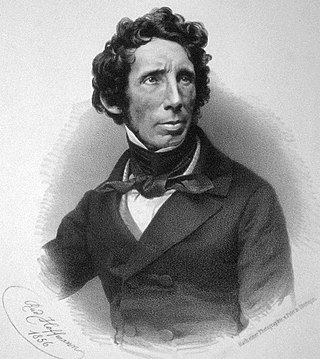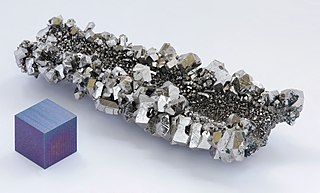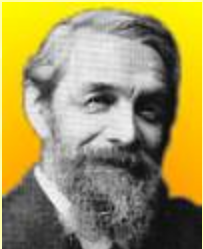Related Research Articles

Dubnium is a synthetic chemical element with the symbol Db and atomic number 105. It is highly radioactive: the most stable known isotope, dubnium-268, has a half-life of about 16 hours. This greatly limits extended research on the element.

Friedrich Wöhler FRS(For) HonFRSE was a German chemist known for his work in both organic and inorganic chemistry, being the first to isolate the chemical elements beryllium and yttrium in pure metallic form. He was the first to prepare several inorganic compounds, including silane and silicon nitride.

Lutetium is a chemical element with the symbol Lu and atomic number 71. It is a silvery white metal, which resists corrosion in dry air, but not in moist air. Lutetium is the last element in the lanthanide series, and it is traditionally counted among the rare earth elements; it can also be classified as the first element of the 6th-period transition metals.

Niobium is a chemical element with chemical symbol Nb and atomic number 41. It is a light grey, crystalline, and ductile transition metal. Pure niobium has a Mohs hardness rating similar to pure titanium, and it has similar ductility to iron. Niobium oxidizes in Earth's atmosphere very slowly, hence its application in jewelry as a hypoallergenic alternative to nickel. Niobium is often found in the minerals pyrochlore and columbite, hence the former name "columbium". Its name comes from Greek mythology: Niobe, daughter of Tantalus, the namesake of tantalum. The name reflects the great similarity between the two elements in their physical and chemical properties, which makes them difficult to distinguish.

Tantalum is a chemical element with the symbol Ta and atomic number 73. Previously known as tantalium, it is named after Tantalus, a figure in Greek mythology. Tantalum is a very hard, ductile, lustrous, blue-gray transition metal that is highly corrosion-resistant. It is part of the refractory metals group, which are widely used as components of strong high-melting-point alloys. It is a group 5 element, along with vanadium and niobium, and it always occurs in geologic sources together with the chemically similar niobium, mainly in the mineral groups tantalite, columbite and coltan.

Charles Hatchett FRS FRSE was an English mineralogist and analytical chemist who discovered the element niobium, for which he proposed the name "columbium".

Group 3 is the first group of transition metals in the periodic table. This group is closely related to the rare-earth elements. It contains the four elements scandium (Sc), yttrium (Y), lutetium (Lu), and lawrencium (Lr). The group is also called the scandium group or scandium family after its lightest member.

Group 5 is a group of elements in the periodic table. Group 5 contains vanadium (V), niobium (Nb), tantalum (Ta) and dubnium (Db). This group lies in the d-block of the periodic table. This group is sometimes called the vanadium group or vanadium family after its lightest member; however, the group itself has not acquired a trivial name because it belongs to the broader grouping of the transition metals.

Jean Charles Galissard de Marignac was a Swiss chemist whose work with atomic weights suggested the possibility of isotopes and the packing fraction of nuclei. His study of the rare earth elements led to his discovery of ytterbium in 1878 and co-discovery of gadolinium in 1880.

Anders Gustaf Ekeberg was a Swedish analytical chemist who discovered tantalum in 1802. He was notably deaf.

Heinrich Rose was a German mineralogist and analytical chemist. He was the brother of the mineralogist Gustav Rose and a son of Valentin Rose. Rose's early works on phosphorescence were noted in the Quarterly Journal of Science in 1821, and on the strength of these works, he was elected privatdozent at the University of Berlin from 1822, then Professor from 1832.

Aurin, sometimes named rosolic acid or corallin is an organic compound, forming yellowish or deep-red crystals with greenish metallic luster. It is practically insoluble in water, freely soluble in alcohol. It is soluble in strong acids to form yellow solution, or in aqueous alkalis to form carmine red solutions.
Pelopium was the proposed name for a new element found by the chemist Heinrich Rose in 1845. The name derived from the Greek king and later god Pelops, son of Tantalus. During the analysis of the mineral tantalite he concluded that it does contain an element similar to niobium and tantalum. The similar reactivity of niobium and tantalum complicated preparation of pure samples and therefore several new elements were proposed, which were later found to be mixtures of niobium and tantalum.

Georges Urbain was a French chemist, a professor of the Sorbonne, a member of the Institut de France, and director of the Institute of Chemistry in Paris. Much of his work focused on the rare earths, isolating and separating elements such as europium and gadolinium, and studying their spectra, their magnetic properties and their atomic masses. He discovered the element lutetium. He also studied the efflorescence of saline hydrates.
Picoline refers to any of three isomers of methylpyridine (CH3C5H4N). They are all colorless liquids with a characteristic smell similar to that of pyridine. They are miscible with water and most organic solvents.

Christian Wilhelm Blomstrand was a Swedish mineralogist and chemist. He was a professor at the University of Lund from 1862-1895, where he isolated the element niobium in 1864. He developed an early version of the periodic table and made advances in understanding the chemistry of coordination compounds. Blomstrand published textbooks in chemistry and was well-known internationally for his scientific contributions.
Dianium was the proposed name for a new element found by the mineralogist and poet Wolfgang Franz von Kobell in 1860. The name derived from the Roman goddess Diana. During the analysis of the mineral tantalite and niobite he concluded that it does contain an element similar to niobium and tantalum. The symbol was Di.
Gnomium was the proposed name for a new element similar to nickel and cobalt. Gerhard Krüss and F. W. Schmidt thought that existence of this element would solve an apparent problem in the periodic table.
Georg Karl Brauer was a German chemist.
References
- ↑ Hermann, R. (1847). "Untersuchungen über das Ilmenium". Journal für Praktische Chemie. 40: 457–480. doi:10.1002/prac.184704001110.
- 1 2 Marignac, Blomstrand, H. Deville, L. Troost und R. Hermann (1866). "Tantalsäure, Niobsäure, (Ilmensäure) und Titansäure". Fresenius' Journal of Analytical Chemistry. 5 (1): 384–389. doi:10.1007/BF01302537. S2CID 97246260.
{{cite journal}}: CS1 maint: multiple names: authors list (link) - ↑ Gupta, C. K.; Suri, A. K. (1994). Extractive Metallurgy of Niobium. CRC Press. pp. 1–16. ISBN 0-8493-6071-4.
- ↑ Marignac, M. C. (1866). "Recherches sur les combinaisons du niobium". Annales de chimie et de physique (in French). 4 (8): 7–75.
- ↑ Hermann, R. (1871). "Ueber ein einfaches Verfahren zur Trennung der Säuren des Niobiums von denen des Ilmeniums". Zeitschrift für Analytische Chemie. 10: 344–348. doi:10.1007/BF01354144. S2CID 96176382.
- ↑ The Chemical Gazette, Or, Journal of Practical Chemistry, in All Its Applications to Pharmacy, Arts and Manufactures, Volume 4, by William Francis; page 451; published 1846, by Richard and John E. Taylor; via Google Books